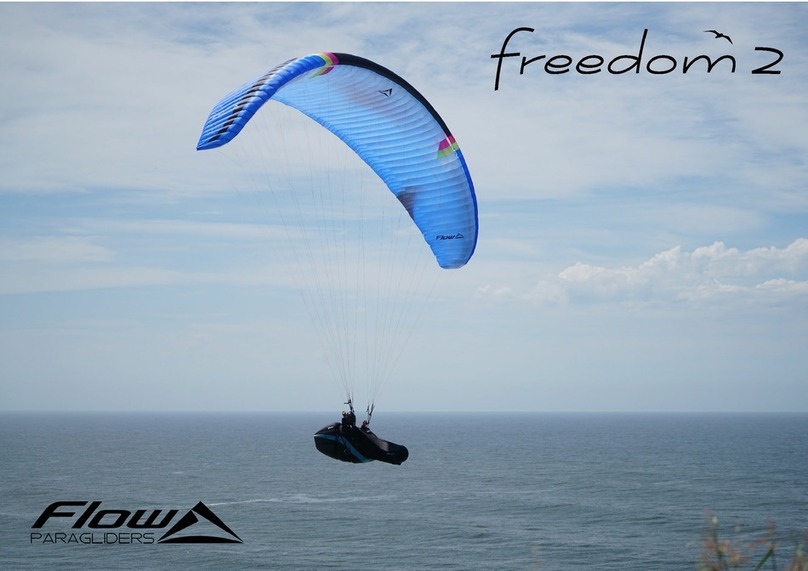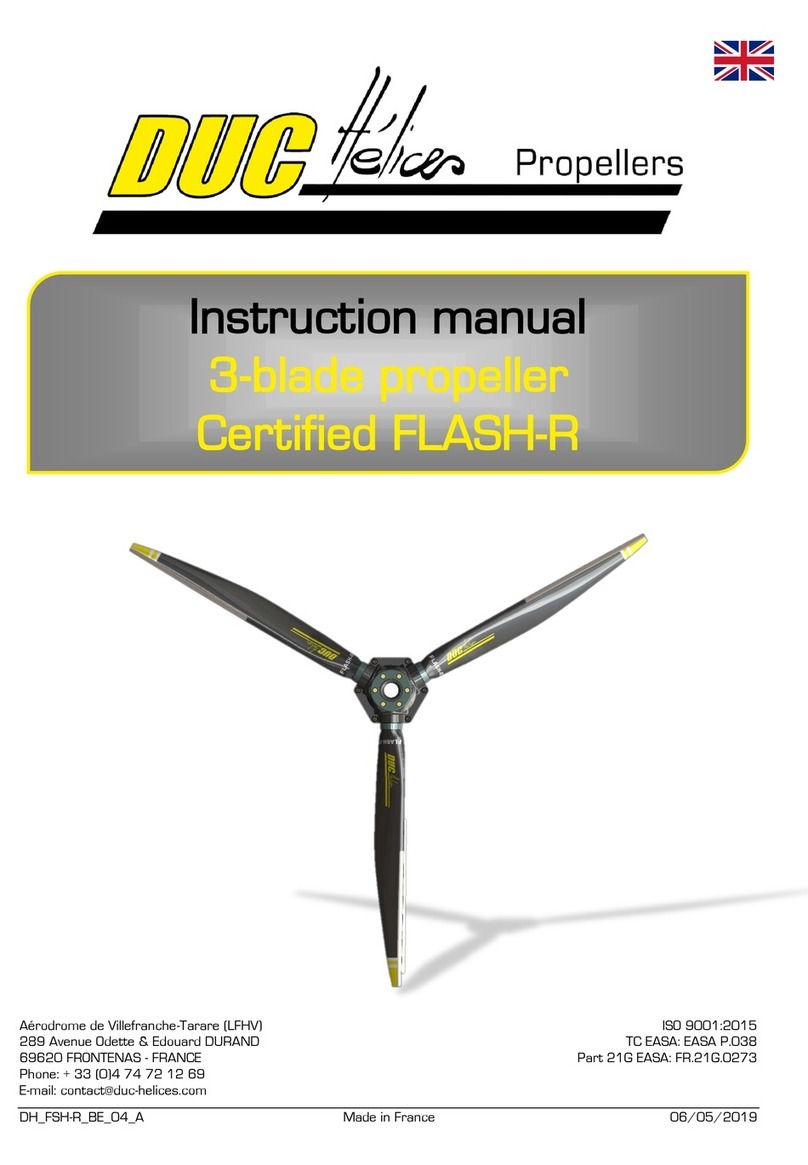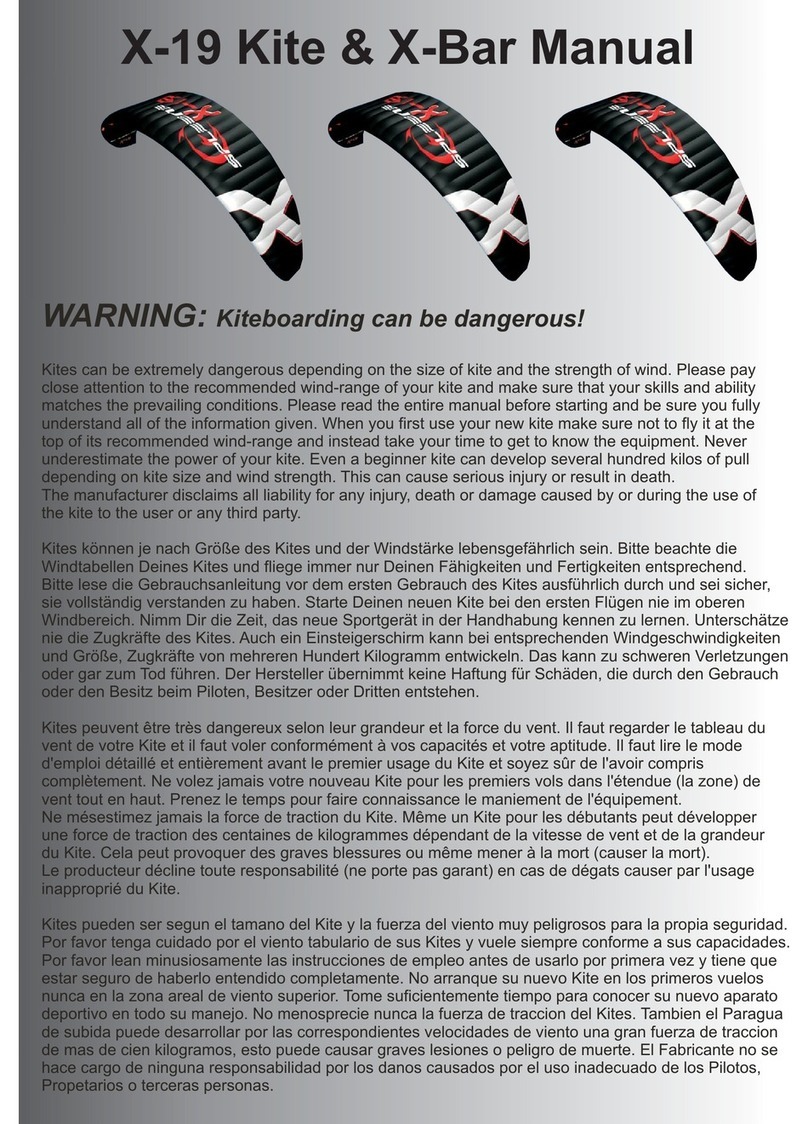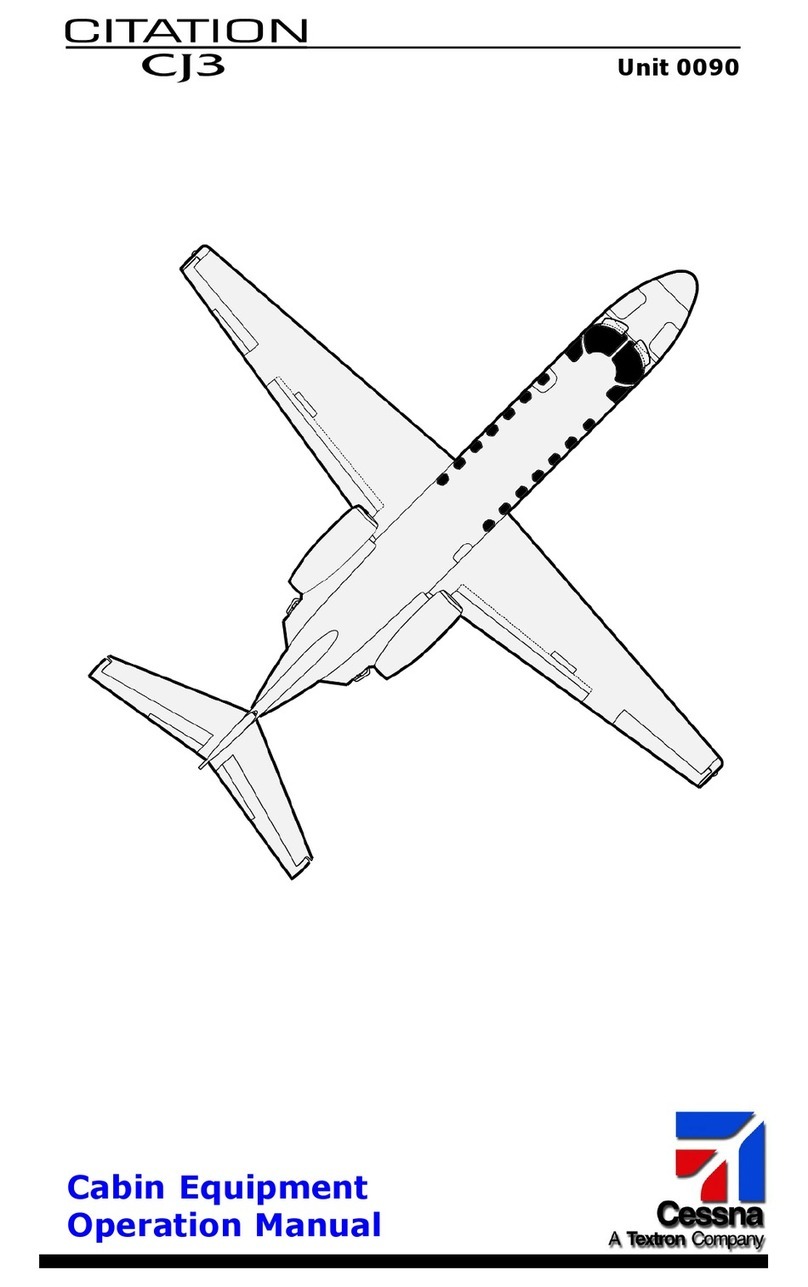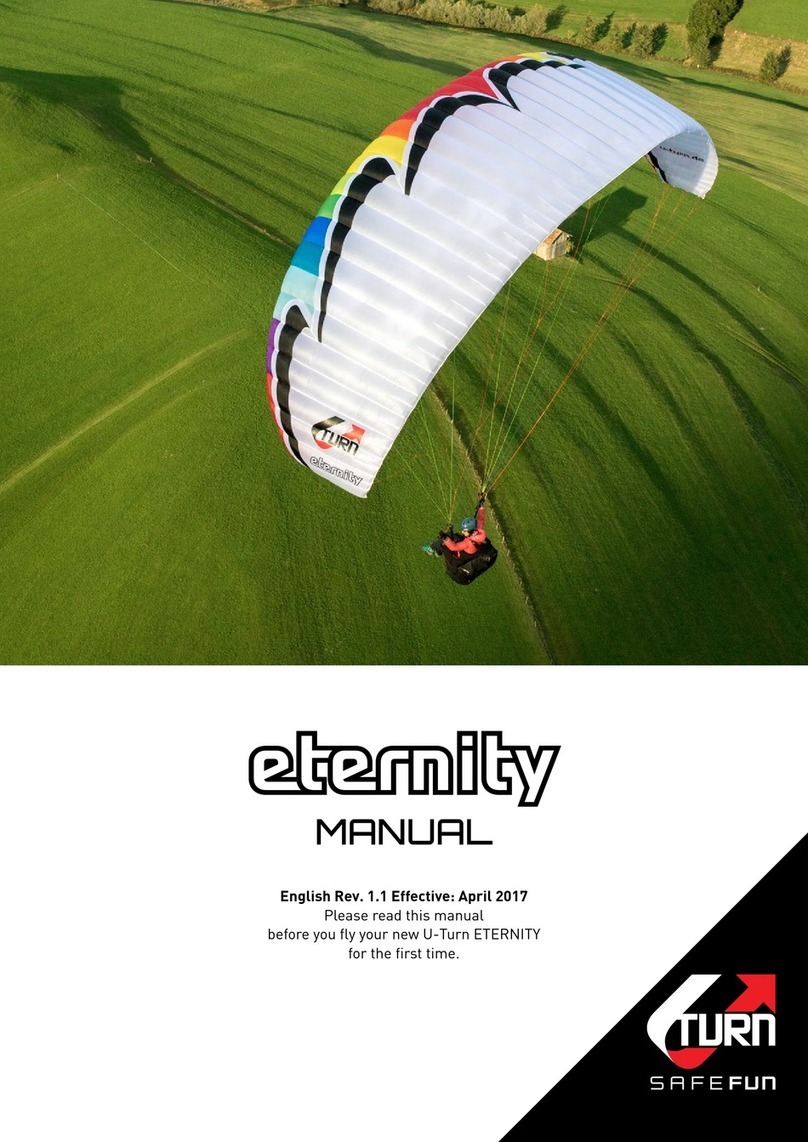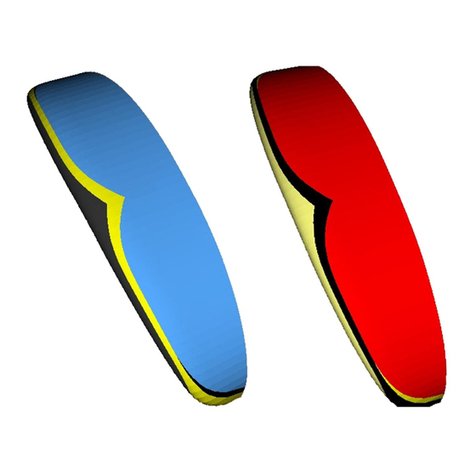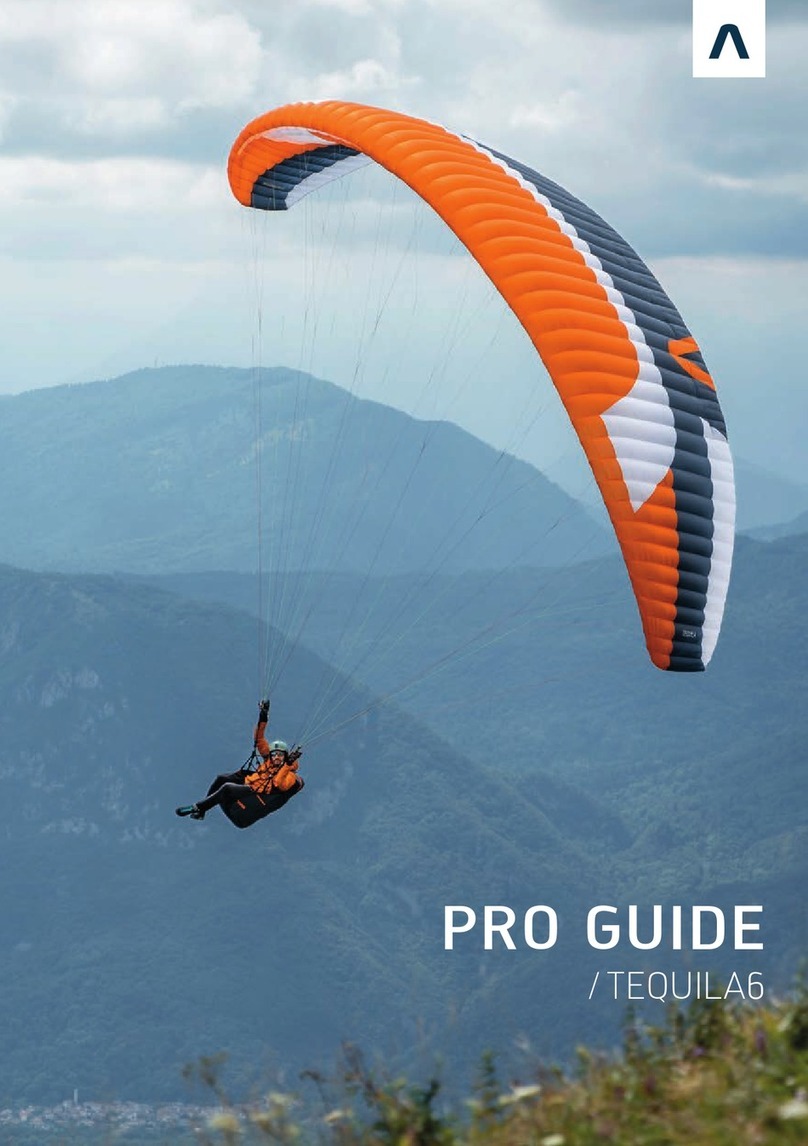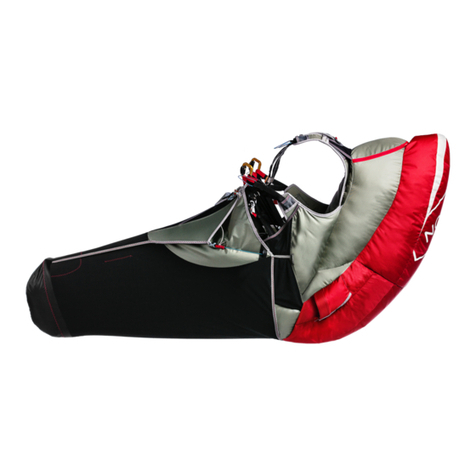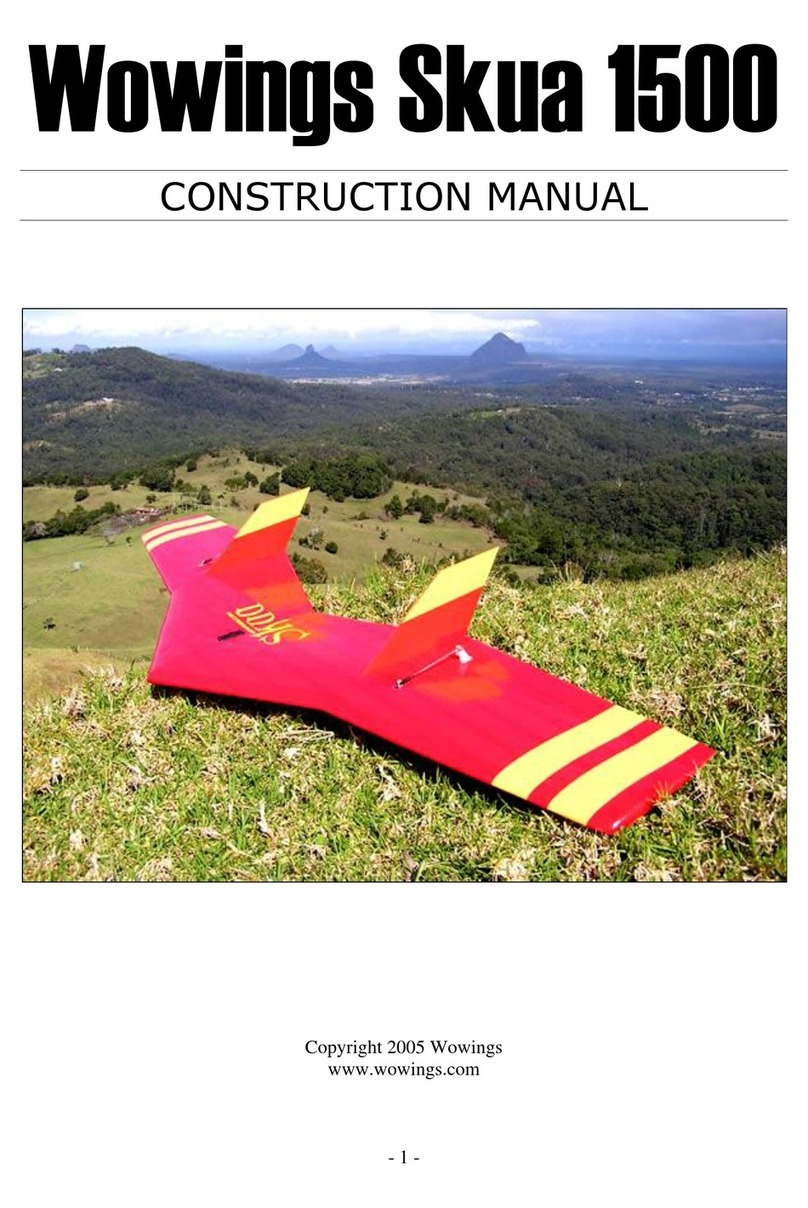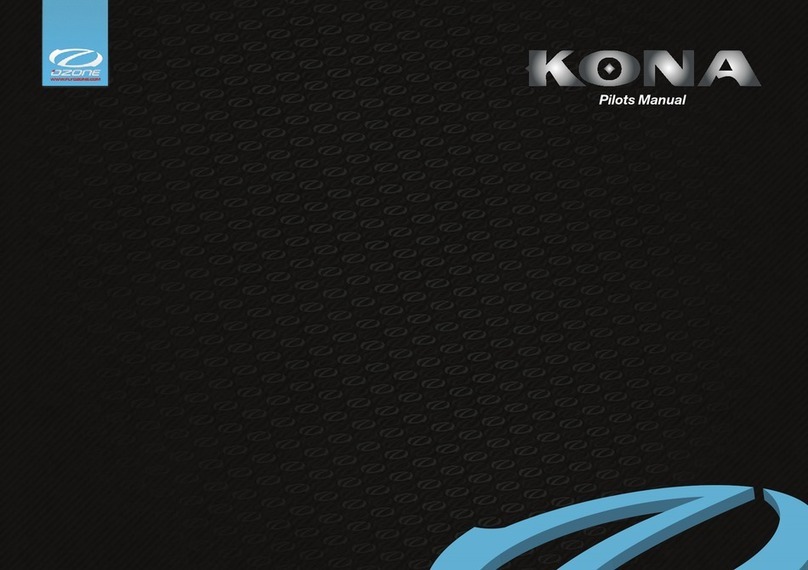Flow Paragliders Spectra User manual

1

2
WELCOME
Thank you for flying Flow paragliders. We hope you will be satisfied with this product and wish you many happy flights. We strongly recommend
that you read this manual before the first flight. This manual is designed to help you to quickly familiarize with this beautiful glider.
The Flow Paragliders’ Spectra is our CCC 2 liner designed for the ambitions pilot. The Spectra design bridges the gap between sophistication and
simplicity where clever design solutions were adopted to minimise unnecessary complexity in paragliding design which usually leads to extra
weight and drag. We concentrated in key areas and perfected those elements where performance was achieved without compromising safety.
The Spectra has numerous hidden features that can be observed by the trained eye. The Spectra is a cohesive glider both in climb and glide and
pilots who are accustomed to fly high performance gliders will feel comfortable and at ease to fly the Spectra to the maximum.

3
Welcome 2
1. General Information 4
2. Certification 4
3. Pilot’s Profile 6
4. Specifications 7
5. Take Off and Flying Techniques 8
5.1 Before take-off 8
5.2 Take-off 8
5.3 Landing 9
5.4 Turning 9
6. Rapid Descent 9
6.1 Spiral Dive 9
6.2 B-line 10
6.3 Big Ears 10
7. Performance 10
7.1 Use of Brakes 10
7.2 Active B-risers 10
7.3 Use of Speed Bar 10
8. Asymmetric & Frontal Collapses 11
8.1 Asymmetric Collapse 11
8.2 Frontal Collapse 11
9. Full Stall 12
10. Flying without Brakes 12
11. Cravat 12
12. SIV and Collapse Lines 13
13. Adjustment of the Harness 13
14. Maintenance & Checks 14
14.1 Maintenance Tips 14
14.2 Periodic Inspections 15
15. Warranty 15
16. Summary 16
17. Line Plan 17
18. Riser Diagram 17
19. Materials 18
20. Line Measurements 20
21. Bridle Check-Sheet Lengths S 21
22. Canopy Measurements 23

4
General information
User manual for the Spectra
This manual offers all the necessary information that will familiarise you with the main characteristics of your new paraglider. Although this manual
informs you about your glider, it does not offer the instruction requirements necessary for you to be able to pilot this type of wing. Flying instruction
can only be taught at a paragliding school recognized by the Flying Federation of your country. Nevertheless, we remind you that it is important
that you carefully read all the contents of the manual for your new Spectra.
The Flow Spectra has been certified as a CCC, having met all the requirements of EN 926-1 strength tests and CIVL CCC Paragliders 2018 Revision
1.9.
This user manual version V02.06 is dated: 04/2019.

5
Please note that any changes to the paraglider will invalidate the result of the certification. Correct usage of the glider is the pilot‘s responsibility.
The manufacturer and distributor do not accept liability for loss or damage as a result of the misuse of this paraglider. It is the pilot’s responsibility
to comply with legal regulations and to maintain the airworthiness of the aircraft.
This guide meets the requirements specified by EN 926-2:2005 as well as LTF NFL II 91/09 for user manuals.

6
PILOT’S PROFILE
The Spectra was built for the experienced competition pilots who are looking for a top-level performance glider in a comfortable and accessible
package. Spectra’s biggest quality is its stability while on bar. Other strengths worth mentioning are its superb glide, its excellent thermaling ability
combined with its incredible top speed. The Spectra is a new glider concept.
Spectra is our CIVL Competition Class glider. Spectra’s design bridges the gap between sophistication and simplicity where innovative and
thoughtful design concepts were adopted to minimize complexity which usually leads to extra weight and drag.
We concentrated on key areas and perfected those elements for improved performance without compromising safety.
This has resulted in a glider which deforms less in turbulence, converts lift more efficiently, offers less distortion when AoA is changed, and has
less parasitic drag.
With 176 leading edge cells and a reduced total line count the Spectra is the vanguard in glide performance and technology.
Spectra has numerous hidden features which can only be observed by the trained eye. Special attention was given to some key elements on the
design, such as:
•leading edge structural integrity
•general internal spanwise and chordwise rigidity and tension
•relative alignment of the airflow in relation to the wingtips, reducing drag.
These hidden technologies combined offer true performance gains and usability.
Spanwise and chordwise tension and rigidity were reinforced to optimize handling and glider solidity.
Spectra is a cohesive glider both in climb and glide and pilots who are accustomed to flying high performance gliders will feel comfortable and at
ease to fly the Spectra and push the glider to the maximum.

7
Even though the Spectra transmits a great deal of comfort in flight it is important to emphasise that a glider of this calibre should only be flown
by pilots who have experience in flying high aspect ratio gliders, who are competent in the recovery techniques. For pilots who understand
about active piloting and who are confident to fly in turbulent conditions and have an understanding of flying high performance 2 liners gliders.
Spectra is not suitable for beginner or intermediate pilots, aerobatics, training or tandem flights.

8
SPECIFICATIONS
S
M
ML
LS
L
XL
FLAT AREA
20.35m2
22.20m2
23.80m2
24.60m2
25.88m2
27.5m2
PROJECTED AREA
17.34m²
18.88m2
20.24m2
21.02m2
21.98m2
23.39m2
FLAT WINGSPAN
12.37m
13.05m
13.49m
13.80m
14.18
14.52m
PROJECTED SPAN
10.08m
10.47m
10.84m
11.22m
11.45m
11.65m
ASPECT RATIO
7.65
7.65
7.65
7.65
7.65
7.65
PROJECTED AR
5.8
5.8
5.8
5.8
5.8
5.8
MAX CHORD
2.06
2.16
2.24
2.32
2.32
2.40
NUMBER OF CELLS
88
88
88
88
88
88
LINE CONSUMPTION
204.84m
216.92m
227.14m
230.20m
238.10m
249.86m
GLIDER WEIGHT
5.9
6.0
6.2
6.25
6.35
6.4
TAKE OFF WEIGHT
80-95
95-105
100-115
105-120
110-125
115-135
CERTIFICATION
CCC
CCC
CCC
CCC
CCC
CCC

9
TAKE-OFF, FLIGHT, AND FLYING TECHNIQUES
The Spectra should be flown as a normal paraglider. However, there are several points listed below which should help you to familiarize with your
new paraglider quicker.
The Spectra was designed as a foot launchable solo paraglider only. The Spectra may be tow-launched. It is the pilot’s responsibility to use suitable
harness attachments and release mechanisms and to ensure that they are correctly trained on the equipment and system employed.
Before take-off
•Check the canopy for rips or tears. Also, inspect the internal structure (ribs, diagonals) and seams.
•Check that the lines are not damaged or tangled.
•Check if the quick links connection between lines to risers are undamaged and tightened.
•Check that the risers are not damaged or twisted.
•Check if the speed system works freely and make sure that the lines are long enough.
•Check that the brake handles are correctly attached and that each line runs freely through the pulley.
Take-off
Lay the paraglider out with the leading edge in a horseshoe shape. Hold the A risers close to the quick links and move forward until the lines get
stretched. You should now be perfectly centred with your wing. With no wind or light headwind, with lines stretched, Spectra inflates rapidly and
rises over your head with some dynamic steps. We recommend that you do not pull risers too forward or down, which could cause a collapse of
the leading edge, but simply follow them until the glider reaches its angle of flight. It is important that the centre of gravity of your body stays in
front of your feet during the inflation of the glider to constantly load the risers. A controlled inflation allows you to check the canopy and lines
during the last phase as it comes up and thus avoids the need to use brakes. Depending on the wind conditions or the slope, an adequate use of
brakes can help you to take-off quicker.

10
Landing
Because of the exceptional glide for this type of glider, high caution is recommended in the stages of approaching and landing. Spectra is a fast
glider, any action on the brakes may cause significant reactions. It is therefore recommended to execute the first flights in a familiar environment
and under easy conditions. With negative steering, there is more time for the manoeuvres to be performed steadily, which results in reducing the
pendulum movements of the paraglider. Reminder: Negative steering involves applying the brakes symmetrically by about 30% of the maximum
range to slow the paraglider and a simultaneous turning by means of releasing the outside brake. Speeding up just prior to landing allows a more
effective flare and therefore a gentler landing.
Turning
Spectra was designed to perform well in turns. Negative steering (see above) on one hand slows the paraglider in certain phases of the flight and
on the other hand reduces excessive rolling during turn reversals. It is not only designed to turn (with approx. 15% brake) but also to fly slowly in
order to help identify the areas of lift and to keep the paraglider flatter to minimize the sink rate in a turn (with 5% brake). Symmetrical brake-
input at 5-10 % enables you to keep your wing under control –to brake further when pitching and to release when the canopy banks up.
RAPID DESCEND
Techniques
In order to descend, the paraglider must fly away from the areas of lift. In case any problems occur, the following techniques might be used to
increase the sink rate.
•Spiral Dive:Spectra is a manoeuvrable wing which responds to any input easily. To initiate the spiral, apply one brake progressively to
about 35% and hold it in its position. The speed of rotation, brake pressure and the centrifugal force experienced, all progressively increase.
The angle or the speed of rotation can be decreased or increased by releasing or pulling the brake by several centimetres. Once mastered
the spiral allows you to descend by more than 10 m/s. Movements which are extremely abrupt or badly synchronized or very quick initiation
of the spiral can result in an asymmetrical collapse or a spin. CAUTION: Spiral dives should be executed with care. To exit the spiral dive,
the kinetic energy must be converted to potential energy by slowly releasing the inside brake.
•B-line Stall:This maneuvre is not possible on this glider. Traditional B-line stalls are not possible with 2 liners. Pulling the B-lines firmly
will result in a full stall. Do not do it.

11
•Big ears: Big ears is a moderate descent method, reaching -3 or -4 m/s, speed reduces slightly between 3 and 5 km/h and piloting becomes
limited. The angle of attack and the wing loading also increases.
Push on the accelerator to restore the wing’s horizontal speed and the angle of attack. To activate ears, take the line amain3 and
simultaneously, smoothly pull them outward and downward. The wingtips will fold in. Let go of the lines and the ears will re-inflate
automatically. If they do not re-inflate, gently pull on one of the brake lines first and then on the opposite side. For directional control while
using the Big Ears, use weight shift.
We recommend the pilot to re-inflate asymmetrically, to avoid unnecessary change on the angle of attack, more so if you are flying near
the ground or flying in turbulence.
PERFORMANCE & USE OF BRAKES
Use of brakes
Spectra’s best glide is at a trim speed (no brakes) –about 39 km/h. The minimum sink rate is achieved by applying approx. 15% of the brakes.
When using more than 30% of the brakes, the aerodynamics and the performance of the glider are likely to deteriorate and the effort to
manoeuvre will increase quickly. In case of extremely high brake pressure there is a great risk of a stall. Which occurs at a full brake travel (100%
of the brakes) 65cm. In normal flying conditions the optimal position for the brakes, in terms of performance and safety, is within the top third
level of the braking range.
Active B Riser Control
When gliding at trim speed or in accelerated flight, we recommend piloting the wing with the B-risers. This gives an improved feel and control
over the wing enabling you to fly actively without using the brakes (which would cause drag and pitch movements). The direct feel allows you to
stop collapses before they happen and maintain higher speeds and higher levels of efficiency.

12
Use of Speed Bar
Spectra is equipped with a speed system. The profile of Spectra has been designed to fly stable through its entire speed range. It is useful to
accelerate when flying in strong winds or in extreme descending air. For fitting and positioning the speed bar consult the instructions of the
harness manufacturer. Before every flight check that the speed bar works freely and that the lines are long enough to ensure that it is not engaged
permanently. Use of the speed bar increases the maximum speed of the paraglider by up to 30% of the trim speed. However, it does reduce the
angle of attack and therefore there is a risk of a frontal (or asymmetric) collapse. We therefore do not advise to use the speed bar near the ground.
ASSYMETRIC & FRONTAL COLLAPSES
Despite the tests proving Spectra recovers on its own after collapses, it is a CCC glider therefore active piloting is recommended in case of an
asymmetric or frontal collapse. Active piloting will reduce the loss of altitude and a change of direction.
Asymmetric collapse
Despite the great stability of the profile of the Spectra, heavy turbulent conditions may cause part of the wing to collapse asymmetrically. This
usually happens when the pilot has not foreseen this possible reaction of the wing. To prevent the collapse from happening, pull the brake line
corresponding to the compromised side of the wing, this will increase the angle of attack. If the collapse does happen, the Spectra will not react
violently, the turn tendency is very gradual and it is easily controlled. Lean your body towards the side that is still flying in order to counteract the
turn and to maintain a straight course, if necessary, slightly slow down the same side. The collapse will normally open by itself but if that does not
happen, pull completely on the brake line on the side, which has collapsed (100%). Do this with a firm movement. You may have to repeat this
operation to provoke the re-opening. Take care not to over-brake on the side that is still flying (turn control) and when the collapse has been
solved; remember to let the wing recover its flying speed.
Bring both brakes down symmetrically to speed up the reopening of the paraglider, and then raise your hands back up immediately.
Frontal (symmetric) collapse
The profile of the Spectra has been designed to widely tolerate extreme changes in the angle of attack. A symmetric collapse may occur in heavy
turbulent conditions, on entry or exit of strong thermals or lack of adapting the use of the accelerator to the prevailing air conditions. Symmetrical
collapses usually re-inflate without the glider turning, but you can symmetrically apply the brake lines with a quick deep pump to quicken the re-
inflation. Release the brake lines immediately to recover optimum flight speed.

13
FULL STALL
Certain behaviour or weather conditions can cause a full stall. This is a serious deviation from normal flight and can be difficult to manage. If a stall
occurs at less than 100 m above the ground, throw your reserve parachute. Main causes of a full stall:
•A poorly timed or an extensive use of brakes when the air speed of the wing is reduced.
•Soaked or heavily drenched leading edge (from rain or a cloud) can result in a stall due to an uneven airflow over the leading edge.
Whatever the cause, a full stall can be either symmetrical or a in a configuration of a spin.
Your first reaction should be to fully raise both hands. This normally allows the glider to return to normal flight but If nothing happens after a few
seconds, apply the speed bar to encourage the wing to regain normal flight. Ensure the glider has returned to normal flight (check your airspeed)
before using the brakes again.
FLYING WITHOUT BRAKES
If a brake line or pulley breaks, it is possible to fly the Spectra using the B-risers (rear riser). The movements must be well controlled as the
deformation of the wing, due to the traction on the B risers, is greater than that produced by using the brakes.
CRAVATS
If the tip of your wing gets stuck in the lines, this is called a cravat. Due to the large amount of drag, cravats can turn your wing into a spiral dive
very quickly. This can be disorientating and difficult to control if allowed to develop. To recover from a cravat immediately, anticipate the
movement of the wing, first stabilise the direction of your wing with outside brake and weight shift. Once you have control of the rotation and
sink rate, apply strong deep pumps of the brake on the cravated side whilst weight shifting away from the cravat. It is important to lean away from
the cravat otherwise you risk spinning or deepening the spiral. The aim is to empty the air out of the wing tip whilst it is unloaded. Correctly done,
this action will clear the cravat. If it is a very large cravat and the above options have not worked, then a full stall is another option. This should not
be attempted unless you know what you are doing and have a large amount of altitude. Remember, if the rotation is accelerating and you are
unable to re-open the wing or control the decent rate, you should throw your reserve parachute whilst you still have enough altitude.

14
SIV AND COLLAPSE LINES
The Spectra was certified with the use of collapse lines, therefore if you wish to induce collapses during SIV training, collapse lines must first be
installed correctly. Collapse lines are available as an optional extra and should be added to the wing before inducing collapses. The collapse lines
will come with an added-on instruction manual and an extra manual explaining how they should be installed properly. Be sure to attach to both
sides of the canopy for symmetric deflations. Flow Paragliders would like to remind you that SIV manoeuvres should be learnt under the supervision
of a qualified instructor and always used with caution. We strongly recommend expert tuition over water with all the necessary safety precautions
in place. Only attempt SIV with this wing if you have previous SIV experience with a high aspect ratio wing. Ensure that you fully understand the
correct and safe use of this equipment before attempting SIV
ADJUSTMENT OF THE HARNESS
For test flights the pilots used ABS harnesses with the following set-up:
SIZE
Distance from seat board
Distance between hang points
Spectra S
43cm
44cm
We recommend adjusting the harness in a very similar way to the test adjustment. Excessive cross-bracing increases the risk of twisting the risers.
A looser setting will result in a tendency to lean towards the collapsed side. Lower hang points reduce the roll-stability of your harness and can
slow down the reopening of asymmetric collapses. Higher hang points (+ 2 up to +4 cm) have no influence on inflight safety and can therefore be
tolerated.

15
MAINTENANCE & CHECKS
The Spectra is sophisticated piece of equipment and should be technically periodically checked to ensure proper airworthiness.
Maintenance tips
The life of your paraglider therefore depends largely on the care which you maintain and use it. To maximize life span of your wing, respect the
following rules:
•Avoid dropping the canopy on its top surface or on its leading-edge during inflation or landing.
•Avoid dragging it across the ground when moving it.
•Don‘t expose it unnecessarily to sunlight.
•Choose a packing technique that doesn‘t damage the plastic rods and that doesn‘t crease the internal structure excessively.
Always use the protective bag to avoid direct contact with the harnesses and buckles of any friction between the blade and the rucksack.
Never store your paraglider when it is damp.
If immersed in sea water rinse immediately with fresh water. Do not use any detergents. Dry your paraglider away from direct light in a dry and
well-aired place.
Empty any foreign bodies from your paraglider regularly, for example sand, stones or animal or vegetable matter which may eventually decay.
Twigs, sand, pebbles, etc. damage tissue in successive folds and organic debris of vegetable or animal origin (insects) can promote mould growth.
Periodic inspections
The paraglider has undergone a series of tests during the production process and consequent flight tests before the delivery. It is delivered with
a standard brake setting same to the one used during the testing. Periodic Checks & Repairs: for safety reasons, it is recommended that the
paraglider is checked at least once a year, or after 100 hours and anytime there is a change in its behaviour. However, if you are a frequent flyer
(more than 100 hrs per year), we recommend that you check your glider every 100 hours. The person performing the check should inform you
about the condition of your glider and if some parts will need to be checked or changed before the next normal service check period.

16
WARRANTY
Spectra is guaranteed for two years or 250 hours against any production fault since the date of purchase.
The guarantee does not cover:
•Damage caused by misuse
•Neglecting the regular maintenance
•Overloading or misuse of the glider
•Damage caused by inappropriate landings
SUMMARY
Safety is the single most important thing in our sport. We recommend to always be alert of the weather, fly as regularly as you can and ground
handle as much as possible. Practicing ground handling will keep your skills alive and will support you especially when conditions at launch aren't
perfect or the site is difficult.
Please always respect the weather! Monitor the conditions and the forecast closely and understand which conditions are right for your level of
flying or for flying in general. Lot's of pilots get hurt due to misjudging weather conditions and we don't want you to be one of them.
We would also like to emphasise respecting our beautiful nature and looking after your flying sites. If you need to dispose the wing, please don't
dispose of it in the normal household waste but in an environmentally responsible way. If you are unsure, please contact your council.

17
LINE PLAN
RISER DIAGRAM

18
Spectra has been designed with 2 risers per side. The A1 riser is covered with RED webbing, to allow for easy identification. The A risers are split
into two, the smaller riser - holding only the outermost A line - is A2 and has been designed this way to make applying big ears simple. They also
feature ergonomic wooden handles for efficient B-riser control. The risers do not feature trimmers.
Sizes S, M, ML, L
Risers
trim
accel
A1
541
401
A2
538
468
B
525
525
Acc.
140
mm
Trimmer
n/a
mm

19
OVERALL ILUSTRATION
MATERIALS

20
In case of any doubts regarding the information in the manual contact your FLOW PARAGLIDERS dealer.
For spare parts or information in how to obtain them get in contact with us directly or with your local dealer.
Flow Paragliders PTY LTD. –11/2 Executive Drive, Burleigh Waters QLD 4220, Australia –[email protected]
CANOPY
FABRIC CODE
SUPLIER
Upper surface
Dominico DOKDO 30D MF/
Porcher SKYTEX 27 CLASSIC 2
Dominico terch Corp. –Korea
Porcher Industries - France
Bottom Surface
Porcher SKYTEX 27 CLASSIC 2
Porcher Industries - France
Supported Ribs
Porcher 7000 E91
Porcher Industries - France
Unsupported Ribs
Porcher 9017 E29
Porcher Industries - France
Leading Edge Reinforcement
2.5/1.8/ Plastic pipe
Porcher Industries - France
Thread
210D/3, 420D/3 –UV coated
Coats Thread - Thailand
SUSPENTION LINES
FABRIC CODE
SUPLIER
Upper Cascades
Edelrid 8000U 130/090/070/050kg - Edelrid
9200 030kg
EDELRID - Germany
Middle Cascades
Edelrid 8000U 190/130/090/070/050kg
Edelrid 9200 030kg
EDELRID - Germany
Main Lines
Edelrid 8000U 360/190/130/050kg
Liros DSL 140kg
EDELRID - Germany
LIROS GMHB - Germany
RISERS
FABRIC CODE
SUPLIER
Shackles
Maillon Rapide
ANSUNG PRECISION - Korea
Riser Webbing
12mm zero stretch polyester webbing
Guth&Wolth GMBH - Germany
Pulleys
Pulleys Ronstan ball bearing
Ronstan - Australia
Table of contents
Other Flow Paragliders Aircraft manuals


